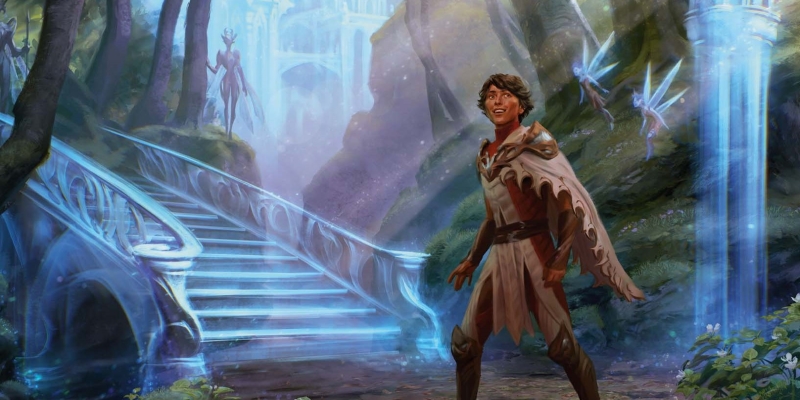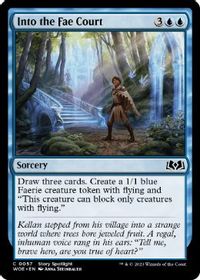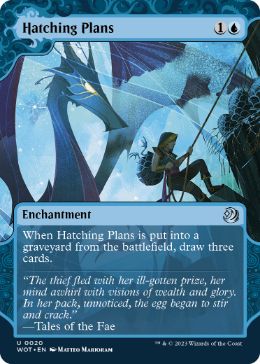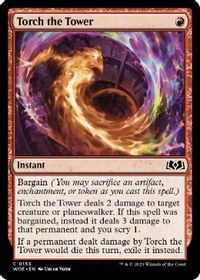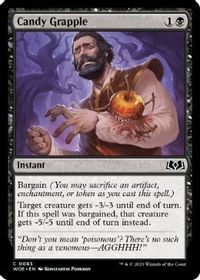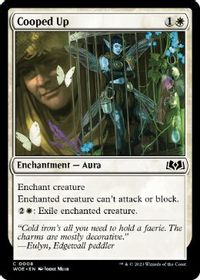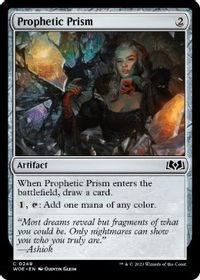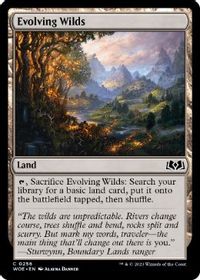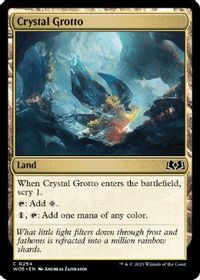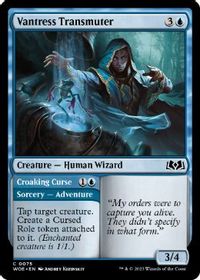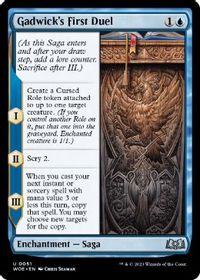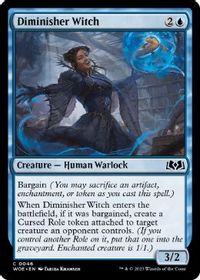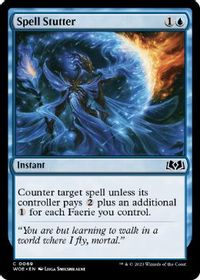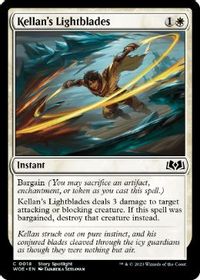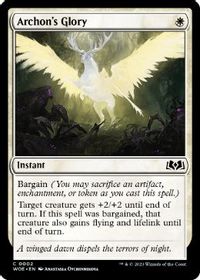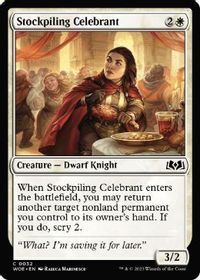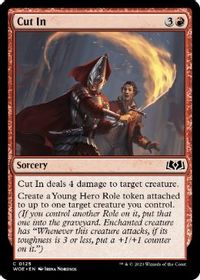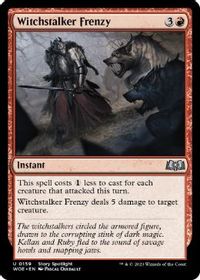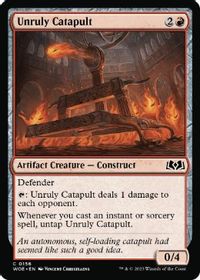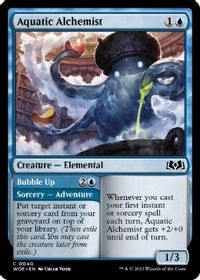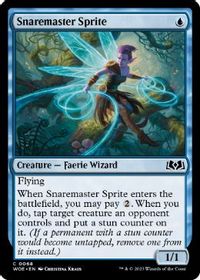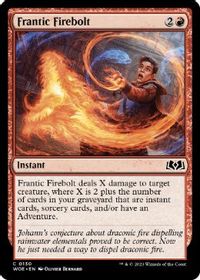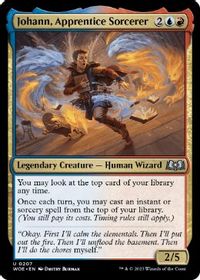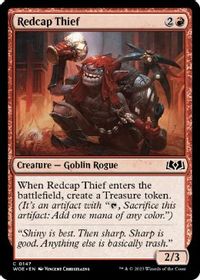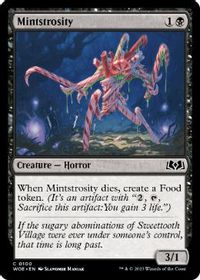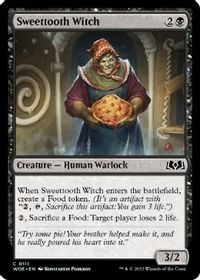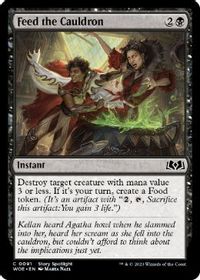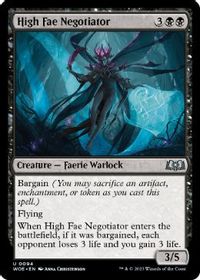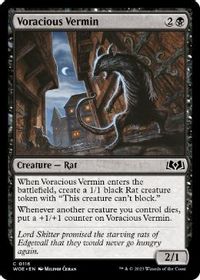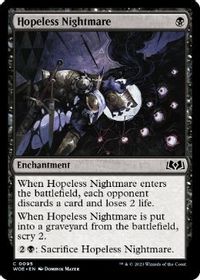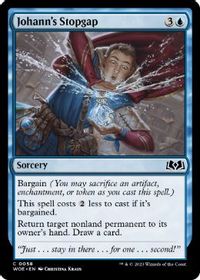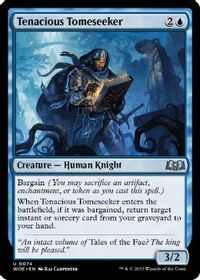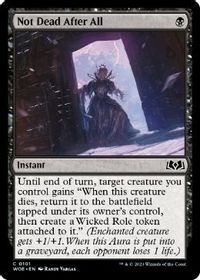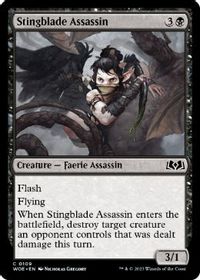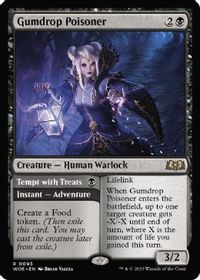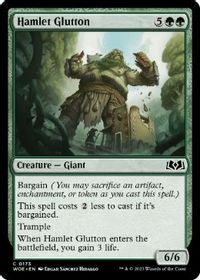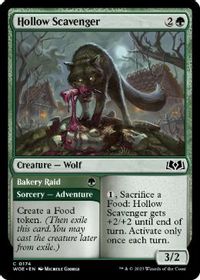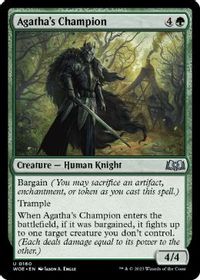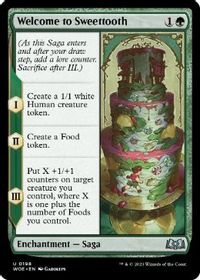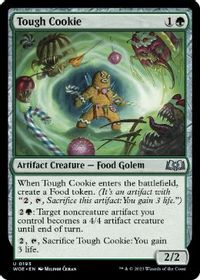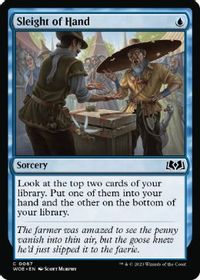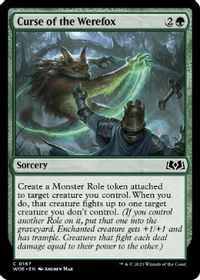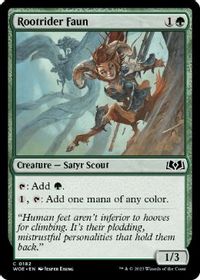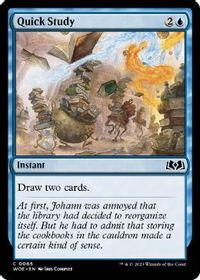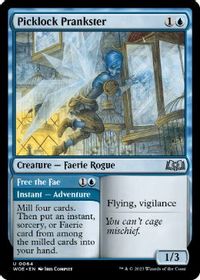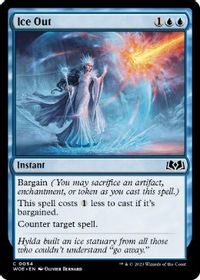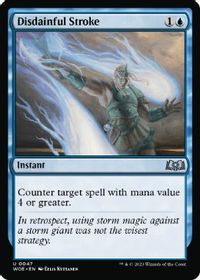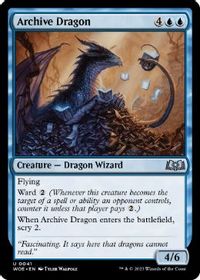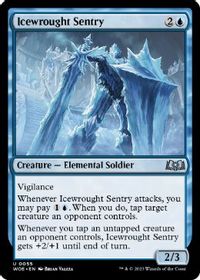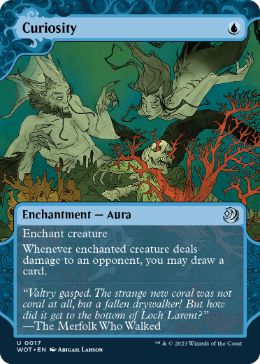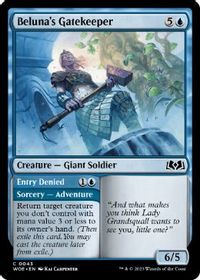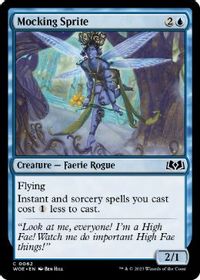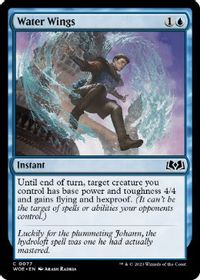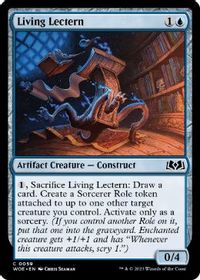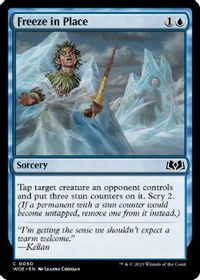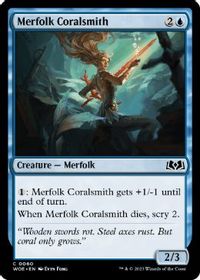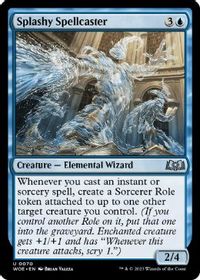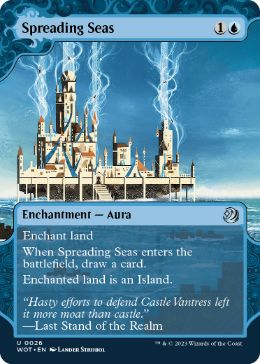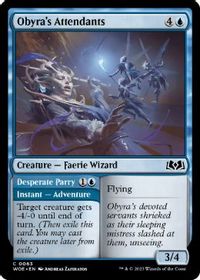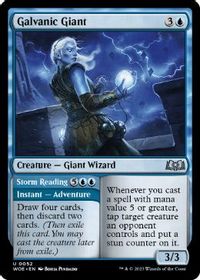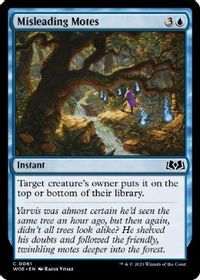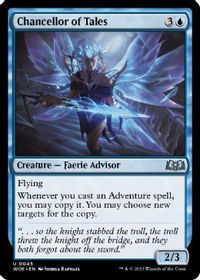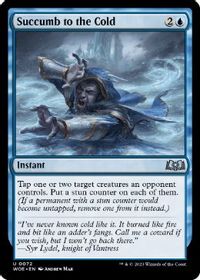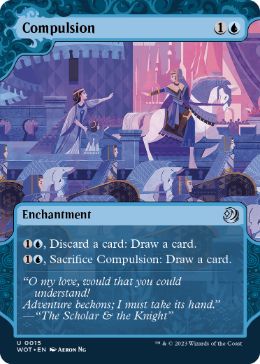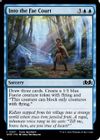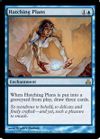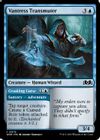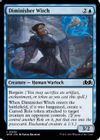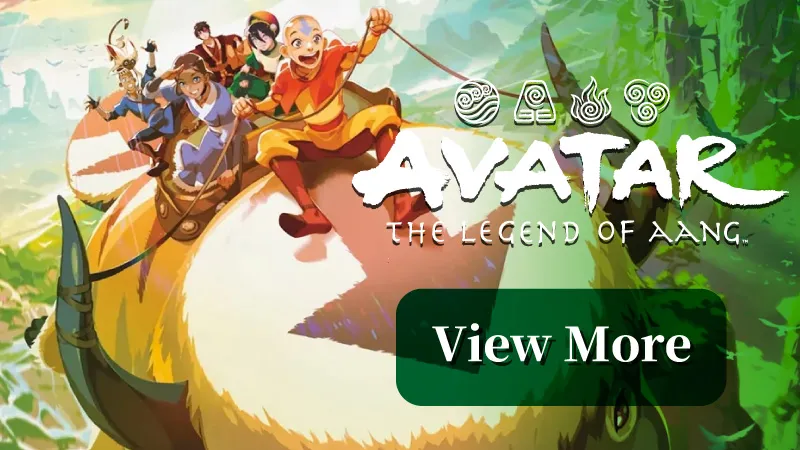Introduction
The MTG World Championships were held at the end of September and one of the formats played there was Wilds of Eldraine draft. I practiced the format, not only because I had to, but because I really liked it. It has become one of my favorite draft formats, and I still feel like I keep learning new things.
There are many viable strategies and interesting build-around uncommons that reward you for drafting unusual decks with specific synergies. Practicing the format a lot has also lead to great results: I went 5-1 in draft at Worlds, and while writing this article I’ve claimed the #1 spot on the MTG Arena ladder on five consecutive days (the streak ended when Vintage Cube 64-mans returned to Magic Online).
One of my secrets to success in this format has been learning how to draft Blue, which is widely regarded as either the worst or the second worst color. If you only look at the cards in a vacuum, that might be true. For example, there aren’t any blue cards that I would be happy to first pick in a draft, which is quite unusual for a color in any draft format. However, almost all of the blue cards are playable, and most importantly they play well together, meaning that you can build strong, cohesive decks out of them that are greater than the sum of their parts.
In this article, I’m going to share with you what I’ve learned about drafting the Blue decks and how to make each color pair work.
Foundation
Let’s start off with something simple. The most important reasons for drafting blue are these two cards:
《Hatching Plans》 is extremely broken and in my opinion the best uncommon in the set. Most of the time it’s going to be a 2 mana draw 3 with upside!!
《Into the Fae Court》 serves a similar role in your draft decks and provides them with a clear plan: stay alive until you can cast your draw spells and win the game by having more resources than your opponent. Which brings us to the difficult part: staying alive.
Drawing extra cards is useless if you die before you get to cast them. That’s why the natural complements to these powerful card draw effects are cheap removal spells and life gain. Unfortunately, Blue itself doesn’t really have either of these.
That’s where the other colors come in handy. Green has life gain and Red has cheap removal, while White and Black have both! The cheap removal spells like 《Torch the Tower》, 《Candy Grapple》 and 《Cooped Up》 are of course highly contested cards, but it doesn’t really matter which ones you have as long as you have some. Blue cards can easily form the majority of the cards in your deck, but they can’t be the only ones – I can’t really imagine a Mono Blue deck being successful in this format, whereas the same is not true for any of the other colors. Cheap interaction is simply essential for the game plan.
That’s why the most common way to end up in Blue is not opening a powerful Blue card, but rather spending your early picks on cheap removal from other colors and then moving into Blue a bit later when you see that it’s open – which it often is.
The cheap interactive spells are so vital for Blue’s strategy that I’m also highly willing to stretch my mana to splash for them. I also tend to pick 《Prophetic Prism》, 《Evolving Wilds》 and 《Crystal Grotto》 higher than most people to enable the splashes.
I’m going to post a bunch of deck pictures throughout this guide to provide practical examples of the concepts being discussed. All of these decks have either made it to 7 wins on an MTG Arena Premier Draft or to the finals of a Single Elimination Draft on Magic Online. I believe it’s highly useful to know what the winning decks look like so you have a range of targets in mind that you can aim for when drafting.
The first ones here are good examples of stretching the mana base:
Speaking of removal, one of Blue’s hidden strengths is access to non-traditional removal in the form of Cursed Roles from 《Vantress Transmuter》, 《Gadwick’s First Duel》 and 《Diminisher Witch》. These cards are great later in the game when they can turn your opponent’s 《Hamlet Glutton》 into 1/1s. Armed with Cursed Roles and counterspells, Blue decks are almost always naturally favored against Green ones, and neither the rolemakers nor the counterspells are cards that you need to pick early. 《Vantress Transmuter》 is my personal vote for the most underrated card in the set. It’s almost like a Blue 《Flametongue Kavu》!
But while the rolemakers and counterspells make you great against big creatures, the flip side of that coin is that Blue decks often struggle against cheap creatures and token makers. Neither spot removal nor cursed roles are good against those. 《Spell Stutter》 can be nice against token makers, but it obviously has its limitations, especially in decks that are built to make the games go long. Just like Blue decks are naturally favored against Green decks, they are also underdogs against Red decks.
Another clear problem area for Blue is the lack of good plays on turn 2. 《Spell Stutter》 is serviceable, but the other options at common are rather uninspiring. This is another issue that you really need your second color to fix.
Color Pairs
Blue-White
The UW theme in this set is about getting benefits from tapping untapped creatures, but in practice these decks tend to be piles of individually good cards instead of relying on the synergies. I think Blue-White is probably the most underrated archetype in the format. These are commonly cited as the worst two colors in the set, but at some point in our testing process for Worlds we checked that this was actually the archetype with the most trophies in our drafts.
One of the appeals here is that 《Cooped Up》 and 《Kellan’s Lightblades》 are less contested than 《Candy Grapple》 and 《Torch the Tower》, and 《Archon’s Glory》 is exceptional as a cheap tempo play that gains you life. In fact, I like 《Archon’s Glory》 so much that I’m often willing to splash for it in the other decks too (as you can see from some of the other deck pics).
《Stockpiling Celebrant》 is also nice as it provides an additional source of card advantage when paired with 《Hopeful Vigil》, 《Prophetic Prism》 and so on, which reduces your reliance on 《Into the Fae Court》. 《Hopeful Vigil》 is a key card here, as it’s significantly better than the other 2 drop options.
Blue-Red
One of Blue-Red’s defining characteristics is that it is the worst Blue color combination against other Red decks, which is naturally more of an issue in Arena and League drafts than pod drafts. Unlike the other color combinations, this one doesn’t have any access to life gain, and it’s particularly vulnerable to decks that are going wide.
That means Blue-Red decks don’t usually have inevitability to the same degree as the other Blue decks. Most of the Red cards are also naturally better in aggressive decks, which leads to most Blue-Red decks being more interested in racing and attacking rather than trying to control the game. 《Cut In》 is particularly great when paired with Blue’s fliers, and tempo positive plays like 《Torch the Tower》 and 《Witchstalker Frenzy》 are even more premium here than in the other archetypes.
The good news is that Blue-Red can use many cards that other decks are not very interested in – 《Unruly Catapult》, 《Aquatic Alchemist》, 《Snaremaster Sprite》 and 《Frantic Firebolt》 among others.
《Johann, Apprentice Sorcerer》 is also a powerful pull to these colors. For the slower, more controlling Blue-Red decks I quite like 《Redcap Thief》 and recommend splashing some cards that gain life.
Blue-Black
One of the major appeals of the Black cards is plentiful access to life gain, which helps the Red matchups a lot. 《Mintstrosity》, 《Sweettooth Witch》, 《Feed the Cauldron》, 《High Fae Negotiator》 and 《Barrow Naughty》 all shine here. Access to Faeries also means that 《Spell Stutter》 is significantly improved here compared to the other Blue decks, especially since you tend to have a lot of other instant and flash cards too that let you easily keep up mana for the counterspell.
《Voracious Vermin》, 《Hopeless Nightmare》 and the various cards that make Food tokens make it easy to enable bargain in Blue-Black, which makes cards like 《Johann’s Stopgap》 and 《Tenacious Tomeseeker》 excel here.
One underrated card that I want to give a shoutout to is 《Not Dead After All》, as it’s another cheap, tempo positive play. One of its major downsides in other Black decks is that it is vulnerable to instant speed removal. If you cast the trick on a creature in combat and it gets killed in response by a 《Candy Grapple》, you end up down a card.
However, in Blue-Black this is less of an issue than usual, because you can back it up with counterspells. 《Not Dead After All》 also combines beautifully with 《Stingblade Assassin》 and 《Gumdrop Poisoner》.
Blue-Green
This was one of my favorite Blue-Green decks, and I find it aesthetically pleasing that the deck is able to splash exactly one card from each other color while maintaining purity in the basic land department. It is also a very thematic example of how I like to draft the archetype. I think this is probably the best archetype in the format, and definitely the one that I’ve had the most success with personally.
From a high-level point of view, Blue-Green maintains the advantage of the Blue decks over other Green ones. Access to 《Vantress Transmuter》, counterspells and card draw give you the same edge there that we have already discussed. The Green cards, on the other hand, help a lot against the Red decks. For example, 《Hamlet Glutton》 and 《Hollow Scavenger》 are excellent tools there.
In addition, Green has a lot of powerful uncommons like 《Agatha’s Champion》, 《Welcome to Sweettooth》 and 《Tough Cookie》, and the Blue cards like 《Sleight of Hand》 let you see those powerful cards more often. Moreover, the presence of 《Rootrider Faun》, 《Utopia Sprawl》 and card draw in combination with the colorless fixers make it very easy to splash cards from other colors to increase the card quality even further.
That said, splashing cards from other colors is not only a thing you can do, but also a thing you often have to do in Blue-Green. The main problem of this color combination is that neither one has much removal. This is even the worst Green color pair for 《Curse of the Werefox》, and the worst Blue pair for counterspells! For this reason, I pick both the splashable removal spells and the fixers to enable them very highly.
It is hard to overstate the value of 《Rootrider Faun》 here. It is simply irreplaceable for these decks. In addition to helping with the splashes, the ramping ability is naturally very good with card draw. Value over the alternative 2 drops is huge and it should be prioritized accordingly.
Card Evaluations
Next we’ll go through all the Blue commons and uncommons. Many of them are only good in specific circumstances, so it’s important to understand what makes them good or bad so you know when you should be playing them.
《Hatching Plans》《Into the Fae Court》
Heart and soul of the deck. You don’t want too many copies of this effect but the first two are usually important. Third one can be good if you have enough cheap spells to support them and not much other top end. 《Hatching Plans》 is obviously much more forgiving than the 5 mana alternative. Fourth big draw spell is almost always overkill – you don’t really need it and it disproportionately increases the risk of untimely deaths.
《Bitter Chill》
Around the same power level as 《Torch the Tower》 and 《Candy Grapple》, making it better than all the Blue commons. It’s nice that you can put this onto a 2 drop on turn 2, and then later in the game bargain it away to draw a card and get a bonus from your other card when the 2 drop isn’t relevant anymore. This comes up particularly often in Blue-Green with 《Hamlet Glutton》, as the Glutton invalidates most early drops that you’ve put the 《Bitter Chill》 on.
《Quick Study》
Reasonable substitute for 《Into the Fae Court》 if you don’t see any of those during the draft, but a full tier level below in raw power. If you have a lot of other ways to spend your mana or you play mostly at instant speed, then 《Quick Study》 might sometimes become better than the Fae Court. Also synergizes with 《Gadwick’s First Duel》 unlike the more expensive draw spell.
《Vantress Transmuter》
Second best blue common. Almost everything that could attack through the 3/4 body gets bullied hard by the Adventure mode. It can be a bit clunky and you don’t want too many of these either, but the first two are almost always nice to have in your deck. The fact that the Adventure mode taps the creature too can sometimes let you push through a lot of damage and race the opponent, and it also synergizes well with cards like 《Icewrought Sentry》 and 《Hylda of the Icy Crown》.
《Diminisher Witch》
On the surface it looks like it’s similar to the 《Vantress Transmuter》 but in practice it’s worse in many ways. First of all, a 3/2 body for 3 mana is very ineffective in this format. Second, in a lot of decks it’s not at all trivial to have bargainable fodder for the triggered ability.
I still like this against Green decks specifically, but in most other matchups it tends to underperform unless it’s in a deck that is exceptionally good at producing fodder to sacrifice, so I often cut it from my main decks. However, sometimes you need more ways to sacrifice 《Hatching Plans》 and that’s the one thing that the Witch does well.
《Picklock Prankster》
This card is very good if you have enough things in your deck to reliably hit with the adventure mode. I would be a bit lower on this card if Blue wasn’t so desperately looking for 2 drops. Some decks are low on win conditions so milling away key cards is a risk that you should be aware of. At its best in Blue-Black, because the instant+sorcery density tends to be high and there are Faeries to find with it. Note that Faeries aren’t limited to Blue and Black in this set, 《Tuinvale Guide》 and 《Charmed Clothier》 are Faeries too!
《Tenacious Tomeseeker》
When it’s good it’s really good. If you have enough bargain fodder and things to bring back with it, it’s like a 《Flametongue Kavu》 // 《Mulldrifter》 split card. In the first couple of weeks I was very high on the 《Tenacious Tomeseeker》, but lately I’ve felt like it’s hard to find enough bargain fodder for it to be reliable, and without the trigger the rate is really bad, just like with the 《Diminisher Witch》. I would still pick it high early on in the draft, but keep in mind that you need to prioritize the fodder cards to make it work. Some decks also don’t have many good things to buy back with it.
《Johann’s Stopgap》
The bounce spell has similar limitations as the 《Diminisher Witch》 and the 《Tenacious Tomeseeker》, and its value is highly dependent on the rest of your deck. If you have a lot of things that you can sacrifice (Food tokens), some things that you want to sacrifice (《Hatching Plans》), or things that trigger from spells being cast (《Aquatic Alchemist》) this can be very good, but if you’re paying the full 4 mana against a Red deck then you’re probably not winning the game. It also has the issue of being at its best in matchups that are already good for you and and its worst in your worst matchups. That said, if you can reliably cast it for 2 mana it is an excellent card.
《Sleight of Hand》
I would almost always play as many as I can get my hands on, but I don’t prioritize it highly. Any card that I think is important for my game plan is a higher pick than the cantrip, but it’s always going to be good and always better than fillers. Value goes up if you have 《Gadwick’s First Duel》 or 《Aquatic Alchemist》.
《Spell Stutter》《Ice Out》《Disdainful Stroke》
In most color pairs I like 《Spell Stutter》 quite a bit, with the exception of Blue-Green which doesn’t really have any other instants so your 《Spell Stutter》 tend to be somewhat telegraphed and savvy opponents will play around them. The main upside of 《Spell Stutter》 over the other two is that it can be played on turn 2, which helps with the curve issues mentioned earlier.
《Ice Out》 and 《Disdainful Stroke》 are both maindeckable as well, but 《Disdainful Stroke》 is a bit Narrow and there’s an abundance of 3 mana cards in the format which can make it hard and cumbersome to keep up the 《Ice Out》 or double spell with it, unless you can reliably cast it for the bargain cost.
《Archive Dragon》
If you need a win condition then this is one of the better ones, as it dodges most of the removal in the set and has enough toughness to survive through most combat tricks. However, I tend to prioritize 《Into the Fae Court》 as my top end, and you really don’t want to have too many expensive cards. Yet another card that is good in slower matchups but clumsy at keeping a pack of rats in check.
《Icewrought Sentry》
For this card to be good you need to either be an aggressive deck or have other ways of triggering the growth ability. Defensive decks don’t have the time to sink mana into the ability, which means that it doesn’t make it into your deck often, but with the right synergies it becomes borderline broken. For example:
《Curiosity》
In similar fashion to the 《Icewrought Sentry》, it’s not good in most Blue decks, but can be extremely powerful in the right context. It is particularly good in Blue-Red decks, as it combines excellently with 《Unruly Catapult》. For example, it’s fantastic in one of the decks posted in the Blue-Red section above.
《Aquatic Alchemist》
A good 2 drop in Blue-Red specifically, underwhelming in Blue-White and Blue-Black, and unplayable in Blue-Green. This card wants to attack, which is again contrary to what most Blue decks are trying to do. I have gotten some nice blocks with the help of 《Archon’s Glory》 though. In the very late game you can also recur your draw 3, a removal spell or a counterspell for some added value.
《Stormkeld Prowler》
Another case in point of Blue’s 2 drops not being good. If you don’t get to trigger it it’s an awful card, and if your 2 drop needs to wait around until turn 5 before it starts doing something, well, good luck. There are definitely games where this card is good, but the average case is certainly not.
《Beluna’s Gatekeeper》
This is another way in which you can try to mitigate the 2 drop problem, but not a great one. There are decks in which I’m happy to play 1 of these – some decks are in the market for a 6/5 finisher, and others just want to draw cards with 《Up the Beanstalk》. It can also be great against 《Hopeful Vigil》, especially on the draw. I don’t mind putting it into my deck, but I do hope to have better options.
《Gadwick’s First Duel》
Pretty good if you can reliably trigger the third chapter, especially against Green decks where the Cursed Role chapter is at its best. Having a sufficient amount of cheap instants and sorceries is quite common with Red and Black cards, and quite rare with White and Green cards. Notably, the Red and Black removal spells (《Torch the Tower》, 《Candy Grapple》, 《Feed the Cauldron》, 《Frantic Firebolt》) are excellent things to copy with it, whereas the same does not apply to White and Green ones (《Cooped Up》, 《Curse of the Werefox》).
《Mocking Sprite》
Another very contextual card. I think it’s pretty bad in most Blue-White and Blue-Green decks, but sometimes shines in Blue-Red and Blue-Black, mainly because the cost reduction ability is much more useful in the latter pairs. To be more specific, in Red decks it pairs excellently with 《Cut In》, and in Black decks it has natural synergies with 《Faerie Fencing》 and 《Barrow Naughty》 thanks to its creature type.
Reducing the cost of 《Into the Fae Court》 can sometimes be great, but the problem is that the Sprite itself is neither good at blocking nor at racing, exacerbating your issues against aggressive decks. It is also vulnerable to 《Rat Out》 and 《Flick a Coin》.
《Water Wings》
An underrated card, but requires a deck that is at least somewhat interested in creature combat, and gets better the more aggressive your deck is. Turning a creature into a 4/4 is a decent combat trick in this format, and it can also help you push through for a lot of damage if combined with a creature like 《Aquatic Alchemist》 or 《Voracious Vermin》.
Giving extra power to a lifelinking 《Barrow Naughty》 can also swing races. Being able to protect your creatures with hexproof makes this card versatile enough that it’s rarely a dead card. However, these go very late and you can get them for basically free, so you never need to prioritize picking them.
《Living Lectern》
Another 2 drop that you don’t really want to play, but sometimes should. It’s not a very reliable blocker as it gets easily punished by things like 《Minecart Daredevil》 and 《Ferocious Werefox》, so I’m mostly interested in this card in decks that want a Sorcerer Role that draws a card. It works well with creatures like 《Picklock Prankster》 and 《Barrow Naughty》, as both get significantly better from the +1/+1 boost and have flying to get the Scry triggers reliably and repeatedly. In other decks you might just need more things to sacrifice to bargain. For example, this deck was lacking both defensive 2 drops and things to bargain with, which made the 《Living Lectern》 a natural fit:
Another synergy worth mentioning is that the 《Living Lectern》 is good at fueling up 《Specter of Mortality》.
《Freeze in Place》
Stun 3 is a lot, but it does wear off eventually. There are two ways to make this card good: either you need to be interested in disabling a blocker to push through damage, or you need to have a lot of card advantage that you want to buy time for (and which will also offset the loss of card from the Freeze itself). I have only ever played this myself for the first reason in a couple of Blue-Red decks, but my teammate Tristan has put it in a variety of decks and been happy with the card.
《Merfolk Coralsmith》
This card isn’t actually bad, but there are so many better alternatives for a 3 drop that I can’t remember the last time I actually put it into my deck. I wouldn’t feel bad about doing so though. Also, it’s another card that can hit for a lot of damage with 《Water Wings》!
《Splashy Spellcaster》
The 2/4 body is a bit underwhelming and it’s not easy to get multiple triggers out of this guy, because you usually need multiple other creatures AND multiple spells that trigger it AND the time to do all of that, which is a lot of hoops to jump through.
However, I’ve had it be excellent in a deck that had a lot of bargain spells, as I could keep generating the role on the same creature over and over again. That deck also really needed the fodder to be able to recur multiple 《Torch the Tower》 with 《Tenacious Tomeseeker》
《Spreading Seas》
Costing 2 mana without affecting the board is rough on the draw against aggressive decks, but it is a good enabler for bargain cards and sometimes steals games by messing up the opponents mana. It gets better in Blue-White as it’s an enabler for 《Stockpiling Celebrant》, and because 《Archon’s Glory》 is great at making comebacks from low life totals. It is also a valuable sideboard card against 《Utopia Sprawl》 and creature lands.
《Obyra’s Attendants》
Also playable but it’s really rare for a Blue deck to want a 5 drop creature that doesn’t stabilize well.
《Snaremaster Sprite》
I have never had enough synergies for this card to put it into my deck, but I have sometimes lost to it from Blue-Red or Blue-Black decks that have coupled it with a Young Hero role or a Curiosity. See the screenshot in the Blue-Red section for an example deck where it’s good.
《Galvanic Giant》《Misleading Motes》《Chancellor of Tales》《Succumb to the Cold》《Compulsion》
If any of these cards end up in your deck, Blue wasn’t open and you should’ve been drafting a different color.
Conclusion
As you can see, these decks are structurally very similar regardless of the colors: there’s 2-4 card draw spells, some cheap removal, some creatures and some ways to close out the games. All of the roles can be filled by a variety of different cards so you’re not relying on seeing anything specific, you just need something from that category.
I hope this guide gave you a solid understanding of how to draft these decks and will bring you success in your upcoming drafts. The format of this article was a bit different from others I’ve written in the past, so let me know on X(Twitter) if you liked it or have thoughts on how to make more informative and valuable draft guides – this is just the kind of information that I would personally find interesting and useful about draft archetypes.
Until next time,
Matti Kuisma (X)


